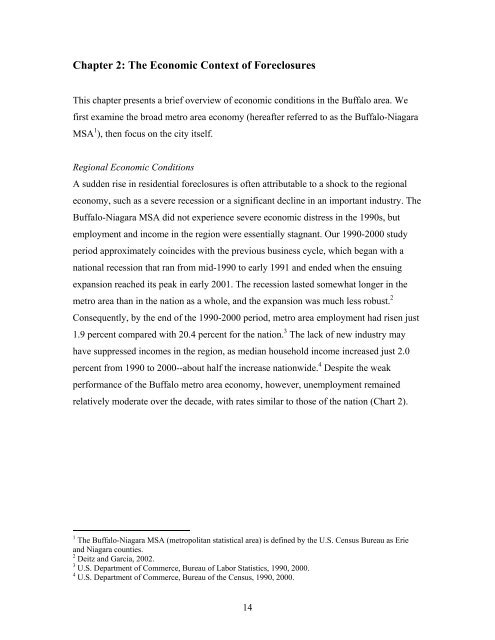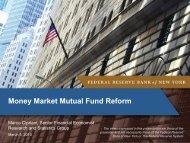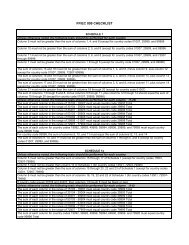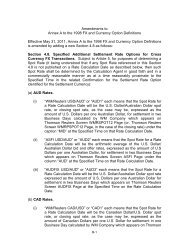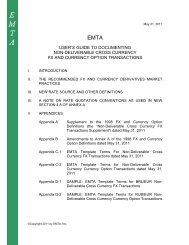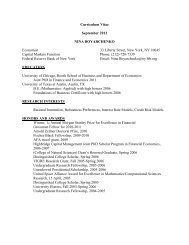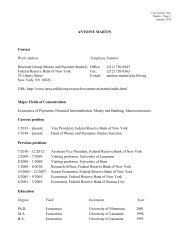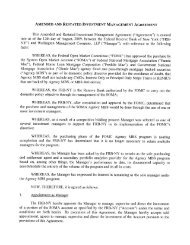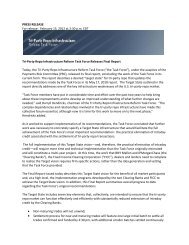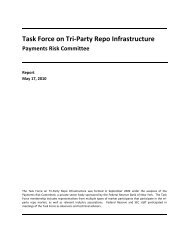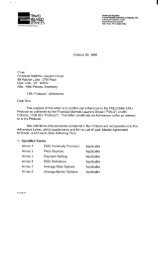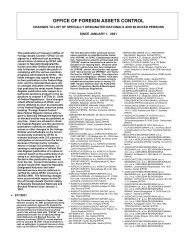Residential Foreclosures in the City of Buffalo, 1990-2000 - Federal ...
Residential Foreclosures in the City of Buffalo, 1990-2000 - Federal ...
Residential Foreclosures in the City of Buffalo, 1990-2000 - Federal ...
Create successful ePaper yourself
Turn your PDF publications into a flip-book with our unique Google optimized e-Paper software.
Chapter 2: The Economic Context <strong>of</strong> <strong>Foreclosures</strong><br />
This chapter presents a brief overview <strong>of</strong> economic conditions <strong>in</strong> <strong>the</strong> <strong>Buffalo</strong> area. We<br />
first exam<strong>in</strong>e <strong>the</strong> broad metro area economy (hereafter referred to as <strong>the</strong> <strong>Buffalo</strong>-Niagara<br />
MSA 1 ), <strong>the</strong>n focus on <strong>the</strong> city itself.<br />
Regional Economic Conditions<br />
A sudden rise <strong>in</strong> residential foreclosures is <strong>of</strong>ten attributable to a shock to <strong>the</strong> regional<br />
economy, such as a severe recession or a significant decl<strong>in</strong>e <strong>in</strong> an important <strong>in</strong>dustry. The<br />
<strong>Buffalo</strong>-Niagara MSA did not experience severe economic distress <strong>in</strong> <strong>the</strong> <strong>1990</strong>s, but<br />
employment and <strong>in</strong>come <strong>in</strong> <strong>the</strong> region were essentially stagnant. Our <strong>1990</strong>-<strong>2000</strong> study<br />
period approximately co<strong>in</strong>cides with <strong>the</strong> previous bus<strong>in</strong>ess cycle, which began with a<br />
national recession that ran from mid-<strong>1990</strong> to early 1991 and ended when <strong>the</strong> ensu<strong>in</strong>g<br />
expansion reached its peak <strong>in</strong> early 2001. The recession lasted somewhat longer <strong>in</strong> <strong>the</strong><br />
metro area than <strong>in</strong> <strong>the</strong> nation as a whole, and <strong>the</strong> expansion was much less robust. 2<br />
Consequently, by <strong>the</strong> end <strong>of</strong> <strong>the</strong> <strong>1990</strong>-<strong>2000</strong> period, metro area employment had risen just<br />
1.9 percent compared with 20.4 percent for <strong>the</strong> nation. 3 The lack <strong>of</strong> new <strong>in</strong>dustry may<br />
have suppressed <strong>in</strong>comes <strong>in</strong> <strong>the</strong> region, as median household <strong>in</strong>come <strong>in</strong>creased just 2.0<br />
percent from <strong>1990</strong> to <strong>2000</strong>--about half <strong>the</strong> <strong>in</strong>crease nationwide. 4 Despite <strong>the</strong> weak<br />
performance <strong>of</strong> <strong>the</strong> <strong>Buffalo</strong> metro area economy, however, unemployment rema<strong>in</strong>ed<br />
relatively moderate over <strong>the</strong> decade, with rates similar to those <strong>of</strong> <strong>the</strong> nation (Chart 2).<br />
1<br />
The <strong>Buffalo</strong>-Niagara MSA (metropolitan statistical area) is def<strong>in</strong>ed by <strong>the</strong> U.S. Census Bureau as Erie<br />
and Niagara counties.<br />
2<br />
Deitz and Garcia, 2002.<br />
3<br />
U.S. Department <strong>of</strong> Commerce, Bureau <strong>of</strong> Labor Statistics, <strong>1990</strong>, <strong>2000</strong>.<br />
4<br />
U.S. Department <strong>of</strong> Commerce, Bureau <strong>of</strong> <strong>the</strong> Census, <strong>1990</strong>, <strong>2000</strong>.<br />
14


